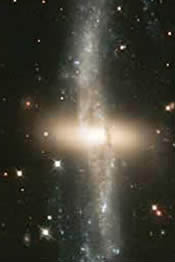polar ring galaxy
A polar ring galaxy (PRG) is a galaxy with a ring of gas, dust, and stars nearly at right angles to the disk of the galaxy. Polar rings occur in almost 5% of lenticular galaxies and in a few spiral galaxies. Understanding their kinematics and evolution is important especially because it can help determine the three dimensional structure of dark matter halos.
 |
There are two main types of PRGs: bulge-dominated lenticulars and disk-dominated later-type galaxies. Lenticulars have narrow rings, while disk-dominated galaxies have wide extended rings. The ring may be a tenuous disk of gas and stars where the central region depleted its quantity of gas and dust into the disk of the host galaxy. Estimated ages of ring/disk systems are on the order of a few billion years. Long exposures capture a small glow coming from the center from stars that formed in between the ring and the disk of the target galaxy. Three main theories have been put forward to explain PRG formation, all involving an influx of mass from outside. The first call for tidal stripping from a host galaxy and can be tested simply by looking at galaxies within a distance that would be reasonable given the age of the given PRG. The other two theories are harder to confirm. Mass can be acquired from a gas rich environment or intercluster medium (ICM). However, if the gas has since been removed from the system, it's a difficult mechanism to confirm. The third proposed formation process involves the total absorption of another galaxy-galactic cannibalism, for which there are observational tests. The topic of dark matter halos comes into play in connection with the rotation curves of PRGs. Halos are used to explain the extended kinematics, such as rotation curves, out to tens of thousands of light-years. Early halo models suggested a spherical structure, but more recent observations reveal better fits to the rotational curves using an elliptical representation, a dark matter halo resembling an E5 to E7 ellipsoid seeming to offer the best fit. One of the nearest PRGs is the Helix Galaxy (NGC 2685).


